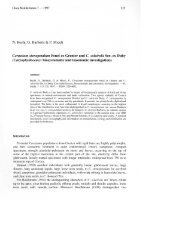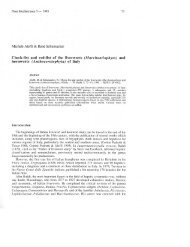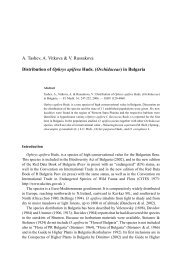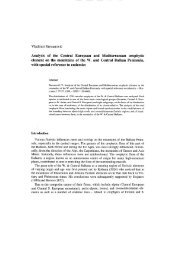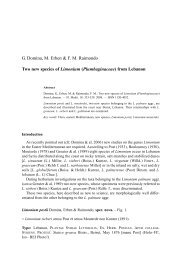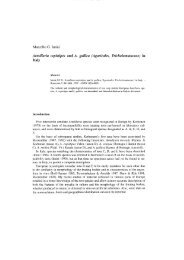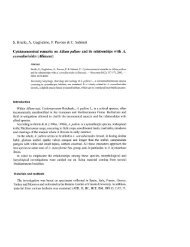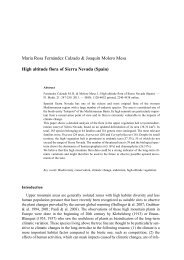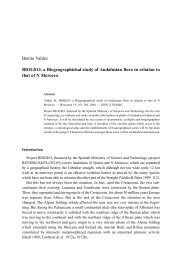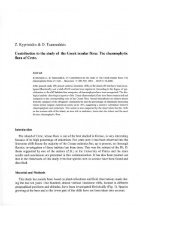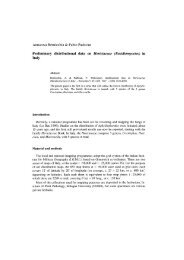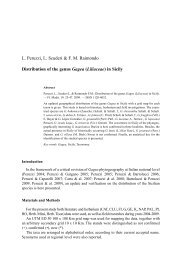Christoph Oberprieler The Systematics of Anthemis L. - Herbmedit.org
Christoph Oberprieler The Systematics of Anthemis L. - Herbmedit.org
Christoph Oberprieler The Systematics of Anthemis L. - Herbmedit.org
You also want an ePaper? Increase the reach of your titles
YUMPU automatically turns print PDFs into web optimized ePapers that Google loves.
22 <strong>Oberprieler</strong>: <strong>Anthemis</strong> in N Africa<br />
conspicuous inhibition zone is found beneath the capitulescence <strong>of</strong> the main axis, and side<br />
axes will arise from the basaI nodes <strong>of</strong> the main axis after its capitulescence has flowered<br />
(Fig. ID). For convenience, such side axes are termed stems in the present revisiono<br />
Some annual N African representatives <strong>of</strong> <strong>Anthemis</strong> (e.g. A. tenuisecta, A. confusa, or<br />
A. glareosa) are characterised by a prostrate habit. <strong>The</strong>ir main axis is reduced and its basaI<br />
intemodes are extremely short (Fig. lE). Reduction <strong>of</strong> the main axis is <strong>of</strong>ten so complete<br />
that branching occurs directly from the taproot (Fig. lF). <strong>The</strong> larger and usually petiolate<br />
lower cauline leaves that normally make up the basaI rosette are almost totally missing;<br />
most leaves are sessile and resemble upper cauline leaves <strong>of</strong> plants with a normally developed<br />
main axis. This character may be used to distinguish between N Tunisian A. ubensis<br />
and the closely related C Tunisian A. confusa: While A. ubensis has an erect habit with a<br />
main axis and leaves that successively decrease in size and dissection from base to top,<br />
A. confusa is characterised by prostrate habit and poorly dissected leaves.<br />
In perennial N African representatives <strong>of</strong> the genus, the trend towards reduction <strong>of</strong> the<br />
main axis is well marked, but realised in a different way. <strong>The</strong> current year's shoots arise<br />
from the lignified bases <strong>of</strong> primary and subsequent shoots <strong>of</strong> the last years (Fig. lG).<br />
Sometimes the main axis is basally more or less completely fused with the taproot to form<br />
a ± subterranean rootstock (caudex) that <strong>of</strong>ten bears both non-flowering and flowering<br />
shoots (Fig. lH). <strong>The</strong> capitulescences are <strong>of</strong>ten reduced to a single capitulum, and rarely<br />
more than three (up to lO) capitula.<br />
<strong>The</strong> stems are usually herbaceous in their distaI part but conspicuously lignified basalIy,<br />
particularly in perennials. Stems formed by the main axis are usualIy straight basally,<br />
while those corresponding to side branches or bome on a rootstock are basalIy bent upwards.<br />
In species with a procumbent habit, only the capitulescence or single peduncles are<br />
lifted above the ground. In alI cases, the stems are round in cross-section and somewhat<br />
sulcate. <strong>The</strong>y are usually green, <strong>of</strong>ten tinged with redin the lower half.<br />
In <strong>Anthemis</strong> maritima in particular, and to a lesser extent in the other perennial representatives<br />
<strong>of</strong> A. sect. Hiorthia, the lower stem nodes may be beset with accessory roots.<br />
Stem length varies considerably with growth conditions: in the perennials <strong>of</strong> <strong>Anthemis</strong><br />
sect. Hiorthia it is 20-40 cm, in representatives <strong>of</strong> A. sect. <strong>Anthemis</strong> and sect. Maruta<br />
usualIy up to 25 cm, but under favourable conditions sometimes much more (e.g. in<br />
A. gharbensis 60 cm, A. cotula 90 cm). Accordingly, the diameter <strong>of</strong> stem bases may vary<br />
between less than 1 mm in poorly developed plants up to 3 or occasionalIy 6 mm in vigorously<br />
growing annuals and some perennials.<br />
Indumentum<br />
<strong>The</strong> indumentum in most N African representatives <strong>of</strong> <strong>Anthemis</strong> consists <strong>of</strong> biseriate<br />
glands and medifixed covering hairs, as already found by Napp-Zinn & Eble (1980).<br />
Medifixed hairs are usually bome on a stalk formed by 2-4 (sometimes even up to 7)<br />
more or less isodiametic celIs and a large, strongly elongated apical celI that is symmetrically<br />
or asymmetricalIy suspended at the tip <strong>of</strong> the stalk. While the stalks may reach a<br />
length <strong>of</strong> c. 50-80 !lm, the length <strong>of</strong> the apical celI is usualIy found to be 400-1000 !lm. In<br />
some species, extremely asymmetrically medifixed apical cells are found. Sometimes,<br />
especialIy on peduncles and involucral bracts, asymmetry is so marked that the apical celI<br />
is no longer medifixed and an uniseriate flagellar covering hair is formed. <strong>The</strong>se hairs are



